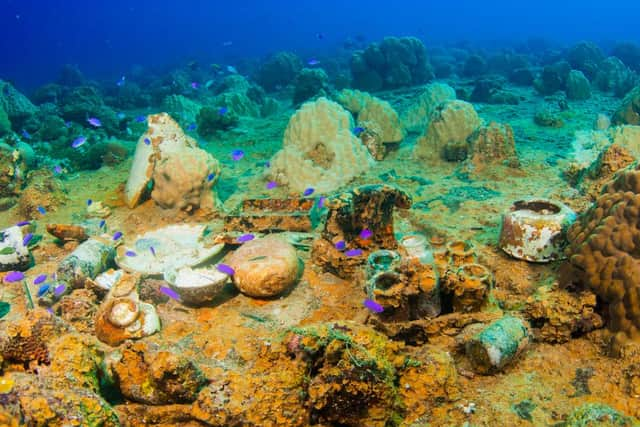Treasure island: the submerged world of Britain's lost shipwrecks


This is part one of a three-part series on Britain’s shipwrecks. To read all three parts, please follow this link.
At pains to maintain public morale in the early stages of war, British authorities quickly hushed up news of the RMS Oceanic’s wrecking after it ran aground off the coast of Foula, Shetland, on a calm September day in 1914.
Advertisement
Hide AdAdvertisement
Hide AdThe crew, later court-martialled for their poor navigation, were saved. The Oceanic, however, was swallowed whole into the Shaalds of Foula, becoming the Allies’ first passenger ship casualty before the navy could even put it to use.


For decades, the vessel - once the largest passenger ship in the world - lay undisturbed on the sea bed, shielded by geographical remoteness, infamously treacherous tides and a muted historical record. Then, in 1973, diver Alec Crawford became the first in 59 years to see it.
Through some combination of fortuity, perseverance and youthful recklessness, Alec and his diving partner rediscovered the Oceanic through a trial-and-error process of throwing an anchor from a boat until, one day, it stuck.
“The best way I can describe it is like going to a cathedral when it’s almost dark,” recalls Alec, of the moment he came face-to-face with the Oceanic’s colossal engines.
Advertisement
Hide AdAdvertisement
Hide Ad“The visibility wasn’t great so all I could see was the lines of it, and yet, there’s an awesomeness to it, like when you’re standing and looking up at a huge cathedral...you can hardly believe what you’re seeing...it’s almost frightening.”


Diving at the beginning of a boom in ocean exploration, Alec, who later wrote a book on his experiences, would not be the last to rediscover a long-forgotten wreck like the Oceanic; one of thousands that still lie scattered off almost every British coastline.
Best estimates, in fact, place the number of wrecks in UK territorial waters at around 40,000, before even mentioning the thousands more British wrecks abroad. Though finds have accelerated in recent years, the majority remain undiscovered.
Throughout most of history, these wrecks have been protected by oceans once impenetrable to humans beyond a few metres’ depth.
Advertisement
Hide AdAdvertisement
Hide AdOver the past few decades, however, increasingly accessible and sophisticated underwater technology has sparked a new age of exploration, in which people - and man-made robots - are reaching depths previously thought impossible.
For archaeologists, this tech represents a world of opportunity, with unsurveyed wrecks a potential goldmine of information on cultures, people and ancient trade routes that could upend our understanding of human history.
With oceans increasingly accessible to all, however, it’s now a question of who gets there first.
From archaic legislation to “treasure hunting” companies in search of million-pound cargos, wrecks today face a myriad of threats which could limit their longevity for future generations. Without adequate protections, this irreplaceable record of Britain’s maritime history could be gone for good.
“These vast structures just disappear from sight”
Advertisement
Hide AdAdvertisement
Hide AdThe story of most human settlements is one of constant change: buildings are pulled down and rebuilt, roads are paved and new cities spring up from the ruins of old ones.
Shipwrecks, meanwhile, are what marine archaeologist Peter Campbell refers to as “a moment in time”. Providing a unique archaeological capsule of the day the vessel sunk, they are, he says, “perhaps the most valuable type of [archaeological] site”.
Depending on where, and how far down ships are located, they can be discovered in astonishingly pristine conditions, as with the 16th-century Baltic Mary Celeste, discovered in 2019 with guns still in firing position.
Dating from the Age of Discovery, the wreck gave archaeologists unprecedented access to the technologies available to Christopher Columbus on his 1492 journey to the New World.
Advertisement
Hide AdAdvertisement
Hide AdOther wrecks, meanwhile, unlock information from even longer ago, with the 2010 discovery of a 3,000 year old Bronze age ship off the Devonshire coast suggesting European trade networks were thriving much earlier than previously thought.
“In Britain, you have watercraft dating all the way back to the Neolithic period”, explains Campbell, adding that such finds are the “main vector” for helping archaeologists understand “how people moved, traded and interacted with other cultures...these finds have revealed how well-connected people in Britain really were”.
Beyond archaeologists, historic ships - and subsequent wrecks - have long been a subject of fascination among the wider public, many of whom grew up on tales of pirates, seafaring adventures, and, of course, treasure.
“People are endlessly fascinated by these vast structures just vanishing from sight”, says Alec, who recalls a large number of local people and fishermen coming to enquire about his wreck finds during his days as a diver.
Advertisement
Hide AdAdvertisement
Hide AdIt’s a fact perhaps no better demonstrated than by the ensuring cultural phenomenon of the Titanic, a wreck not only immortalised in the iconic 1997 film of the same name, but subject to incessant dives, auctions, arguments and ill-conceived plans - including one involving thousands of ping pong balls - to raise it from the sea bed.
In much the same way as tourists are drawn to the post-human landscape of Chernobyl, people are drawn to wrecks, too, as an eerie monument to disaster, completely frozen in time.
This human loss can be conflicting, says Glenn Gilbert, an amateur diver who has been visiting wrecks for almost a decade:
“Sometimes I do have a [guilty] conscience...I’m getting pleasure from being somewhere where I know people have lost their lives”, he explains.
“Seeing the artefacts people left behind can be very moving...but most divers are very respectful and just look, not touch”.